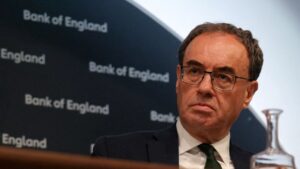Navigating Economic Uncertainty: Insights from the Bank of England
In a rapidly evolving global economic landscape, the U.K. finds itself at a crossroads of opportunity and uncertainty. During a recent press conference on May 8, 2025, Bank of England Governor Andrew Bailey shed light on the current state of the economy, emphasizing that while trade agreements can herald positive change, the dark clouds of uncertainty loom large.
The Impact of Tariffs on the U.K. Economy
Bailey highlighted the complexities introduced by the tariff and trade situation, particularly under the previous U.S. administration’s regime. The U.K. has been proactive in forming a trade agreement with the U.S., a notable achievement in the realm of international trade. However, Bailey warned that this agreement may not single-handedly quell the economic uncertainties faced by the U.K., which operates as an open economy interconnected with global markets.
“The tariff and trade situation has injected more uncertainty into the situation… There’s more uncertainty now than there was in the past,” he stated in an interview with CNBC. This raises a crucial point: the effects of U.S. tariffs will ripple through not just U.K.-U.S. relations but will also influence its trade ties with other countries.
A Hopeful Outlook for Future Agreements
Despite the challenges posed by the current tariff landscape, Bailey remains optimistic. He expressed hope that the U.K.-U.S. trade agreement could mark the beginning of a series of beneficial trade deals. “What we’re seeing on the U.K.-U.S. trade side may be the first of many,” he said, underlining the importance of expanding trade relationships as a mitigating factor against economic uncertainty.
However, it’s important to note that while these agreements are promising, the current tariff levels are generally higher than those that existed prior to the new regime, which could still pose challenges to growth.
The Monetary Policy Report: A Snapshot of Economic Sentiment
Adding to the conversation around uncertainty, the Bank of England’s latest Monetary Policy Report contained the word "uncertainty" 41 times, an increase from 36 instances in the previous report released in February. This highlights a growing recognition among policymakers of the challenges ahead. In response to ongoing economic pressures, the Bank cut interest rates by a quarter percentage point, setting the key rate at 4.25%. This decision wasn’t made lightly; it was a closely contested vote among the Monetary Policy Committee.
Bailey indicated that the divided opinions among committee members reflect the dual risks present in the current economic climate. “We could get a much more severe weakness of demand than we were expecting,” he cautioned. On the flip side, there are valid concerns regarding persistent inflation pressures stemming from various factors, including wages and energy costs, compounded by a weakened supply capacity.
Final Thoughts
For investors and economic stakeholders, staying informed and adaptable is paramount in times of uncertainty. The insights provided by Bailey serve as a reminder of the complex dynamics shaping the U.K. economy. At Extreme Investor Network, we aim to provide you with valuable insights, tools, and strategies to navigate these turbulent waters effectively.
As the economic landscape continues to shift, the importance of understanding these challenges can’t be overstated. By aligning our investment strategies with evolving market conditions, we can better prepare for whatever comes next. Stay informed, stay ahead, and navigate the future with confidence.

